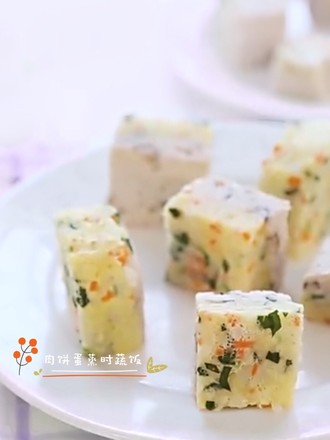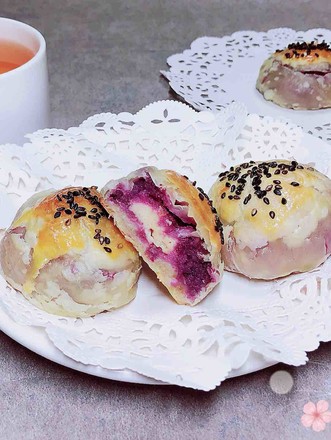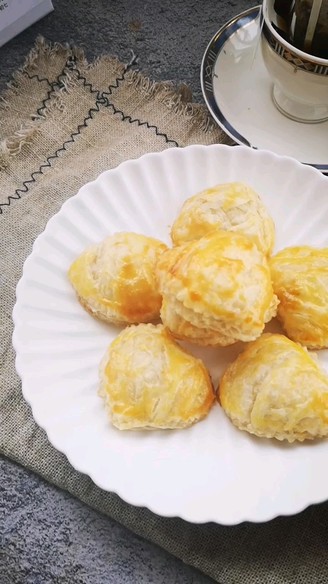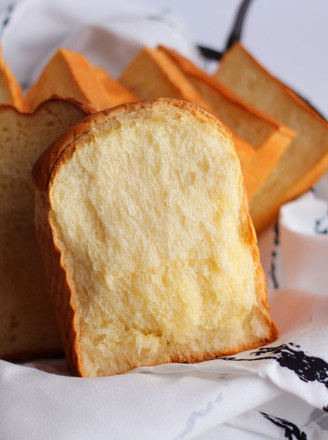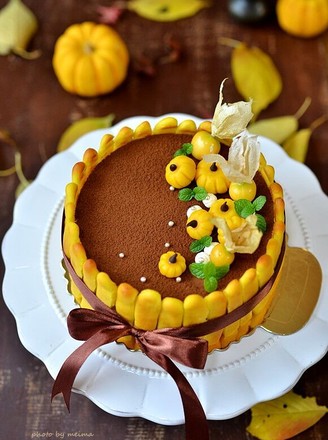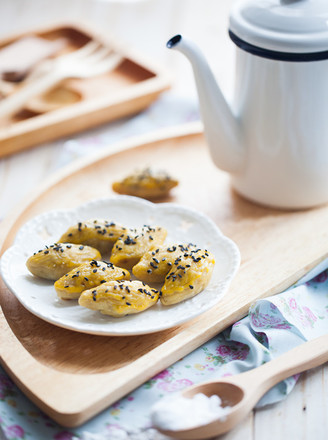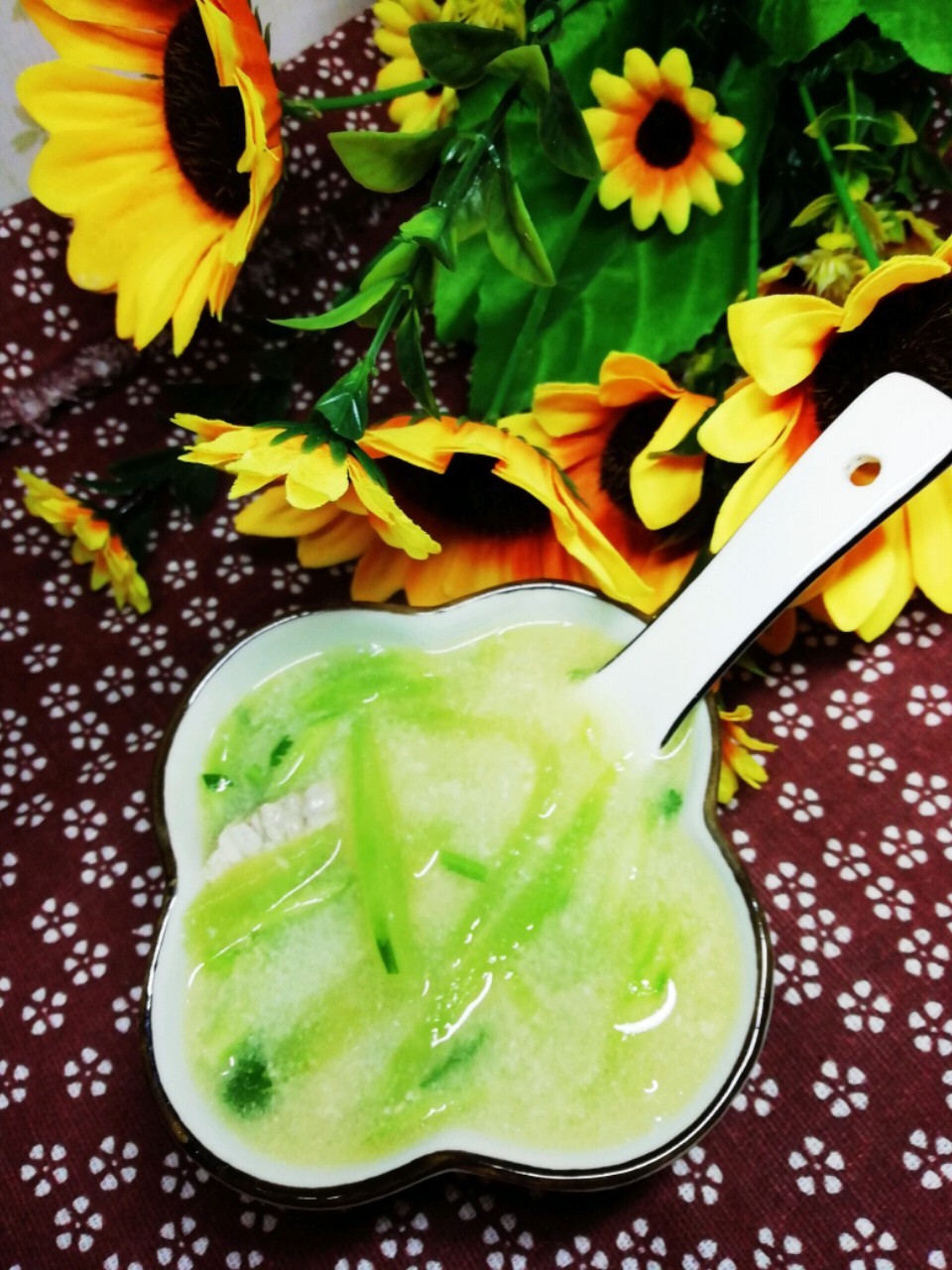[my Baking Time] Happy New Year, Happy Dragon Year, Happy 2012---new Year Cake
1.
First, the cocoa powder is mixed with hot water to make a thick cocoa paste, and let it cool for later use;
2.
1) Low powder and baking powder are mixed evenly;
3.
2) The mixed powder is sieved twice for use;
4.
3) The egg yolks are first broken up with a manual whisk;
5.
4) Pour the granulated sugar into the egg yolk bowl;
6.
5) The fine sugar and egg yolk are beaten evenly with a manual whisk until the fine sugar melts and the egg yolk becomes thicker and lighter in color;
7.
6) Pour in vegetable oil several times;
8.
7) Each time, it must be beaten until the vegetable oil and egg yolk are completely fused before adding the next time;
9.
8) This is the last vegetable oil is added. At this time, the egg yolk paste is obviously thicker and lighter in color. Lifting the whisk, the egg yolk paste will flow down slowly;
10.
9) The milk is poured into the egg yolk paste at one time;
11.
10) Use a whisk to mix the milk and egg yolk paste evenly;
12.
11) Add the cocoa paste after cooling in the basin;
13.
12) Use a whisk to beat the cocoa paste and egg yolk paste together evenly;
14.
13) The powder that has been sieved twice before is then sieved for the third time and sifted into the bowl of egg yolk paste;
15.
14) Use a whisk to beat the powder and egg yolk paste evenly in different directions;
16.
15) The cocoa yolk paste is ready;
17.
16) Add appropriate amount of baking powder, lemon juice and salt to the egg white bowl;
18.
17) Use an electric whisk to beat at a low speed until such a thick bubble;
19.
18) At this time, add 1/3 of the egg white with fine sugar;
20.
19) Use a whisk to beat to a dense and fine foam like soap foam;
21.
20) At this time, add another 2/3 of the fine sugar;
22.
21) The electric egg beater is changed to a high-speed whipping state until the egg white in the basin is beaten;
23.
22) The egg whites can be beaten until hard foaming---lift the egg beater and the egg whites are short and upright sharp;
24.
23) The egg white in the basin is also in such a hard foaming state;
25.
24) The finished cocoa yolk paste and meringue paste, preheat the oven at this time, and the spare chiffon mold should be water-free and oil-free at 175 degrees;
26.
25) First take 1/3 of the egg white paste into the cocoa egg yolk paste;
27.
26) Stir evenly with a rubber spatula;
28.
27) Take another 2/3 of the egg white paste into the egg yolk paste bowl;
29.
28) Continue to stir the egg white paste and egg yolk paste evenly with a rubber spatula;
30.
29) Pour the prepared cocoa chiffon paste slowly into the chiffon mold, first shake it up and down a few times, and then shake it on the table a few times to shake out the big bubbles inside the cake batter; middle and lower layer of the oven, 175 The temperature is 45 minutes; the baked cake will be reversed immediately, and the cake will be demoulded after it has cooled down completely.
31.
30) Cocoa chiffon after demoulding;
32.
31) This is the 8-inch original chiffon baked the day before, and it was taken when two cakes were still baking. The coco chiffon was the same as this without another picture, and it was baked until 25 minutes;
33.
32) The cake climbs like this;
34.
33) Bake until there are ten minutes left;
35.
34) The cake no longer climbs up at this time, and it will shrink a little when it is finally baked, but it is within the normal range;
36.
35) 8-inch cocoa chiffon
37.
Cocoa egg yolk cream coating steps ---1) Pour the egg yolk into the egg yolk bowl with fine sugar;
38.
2) Use a manual whisk to beat the fine sugar and egg yolk evenly until the egg yolk paste becomes thick and light;
39.
3) Pour clean water into a non-stick pan;
40.
4) Pour in granulated sugar and cook into syrup over low heat;
41.
5) When the temperature of the syrup in the pot reaches between 118-120 degrees, the small pot is immediately removed from the fire;
42.
6) Slowly shake the syrup in the pot to make the whole heat evenly, and then pour it into the bowl of egg yolk paste;
43.
7) Pour the syrup and quickly beat with an electric whisk until the egg yolk paste in the basin has completely cooled down;
44.
8) Add the softened butter into the bowl of egg yolk paste twice;
45.
9) Just beat into a smooth and loose butter paste;
46.
10) Sift the cocoa powder into the butter paste;
47.
11) Continue to beat evenly with an electric whisk;
48.
12) The cocoa egg yolk cream frosting is ready. The successfully made cream frosting is smooth, shiny, loose hair and delicate, and can be easily spread on the surface of the cake, and it will not be lumpy and difficult to wipe off;
49.
13) Coco Chiffon cuts off the top layer, the bottom surface is up, and then fills the cut edge into the hole in the middle of the cake;
50.
14) Spread the cocoa yolk cream frosting evenly on the surface and around the cake with a spatula, and then put it in the refrigerator;
51.
15) In addition, bake a piece of pink leopard cake to decorate the cake. After the cake is baked and cooled, use a mold to carve out the desired pattern;
52.
16) Cake decoration---Take out the chilled chiffon, place a heart-shaped cake slice on the top, sprinkle the coconut paste in the middle, then put the strawberry and the whole strawberry on the top of the cake, and finally pour a layer of maple syrup on the surface of the cake That's it.

![[my Baking Time] Happy New Year, Happy Dragon Year, Happy 2012---new Year Cake recipe [my Baking Time] Happy New Year, Happy Dragon Year, Happy 2012---new Year Cake recipe](https://img.simplechinesefood.com/67/6758c295ad5ecf2920e68f2cf966b0de.JPG)
Tips:
1) The preparation of the materials should be done in advance, such as the temperature of the eggs and the flour being sifted twice;
2) The flour is sifted twice first, and then sifted once when it is added to the egg yolk. This is to allow more air to be drawn into the flour, and the baked cake will be looser;
3) Cocoa powder is not easy to mix with the egg yolk paste, so it is best to make the cocoa powder into a paste with hot water in advance, so that it will be easier to mix well when mixing with the egg yolk paste;
4) Whisk the egg whites properly, just hit the hard foam like the one in the picture, or it can be beaten into a nine-point rigid foam that lifts the egg beater and the egg white is slightly curved and sharp;
5) The first added 1/3 of the egg white paste should be fast and light when turning, but it should not be mixed because of the fear of overturning. The first time adding the egg white paste must be evenly mixed with the egg yolk paste;
6) When the chiffon paste is poured into the mold, it should be a little bit away from the mold. This is also done so that the cake batter can draw in more air during the pouring process;
7) After pouring into the mold, there must be a step of vibrating the mold to expel the large bubbles inside, so that the baked cake will not have large cavities inside the tissue;
8) The baking time and temperature are adjusted according to our own oven. 175 degrees 45 minutes is the most suitable for my home oven to bake chiffon, probably adjust up and down according to this temperature and time; the 8-inch chiffon mold is suitable for the middle and lower layer of my home oven , If the oven is smaller, put the middle and lower layer or cover the surface of the cake with a layer of tin foil;
9) The cake should be inverted immediately after the oven is baked. The surface of the cake is stronger than the inside. The inversion is to prevent the surface from pressing against the inside of the cake with a softer tissue;
10) When making the butter cream coating, the temperature of the syrup should be controlled between 118-120. The syrup cooked at this temperature can be smoothly whipped with the egg yolk paste and will not be too thin or too thick. ;
11) The butter must be softened at room temperature before being added to the egg yolk paste;
12) The last thing to pay attention to is that the successful cream frosting is smooth and shiny, with fine loose hair, and can be easily spread on the surface of the cake, and it will not be lumpy and difficult to wipe off.

![[my Baking Time] Happy New Year, Happy Dragon Year, Happy 2012---new Year Cake [my Baking Time] Happy New Year, Happy Dragon Year, Happy 2012---new Year Cake](https://img.simplechinesefood.com/76/76ad936b06c3f845f265af12abe8a839.jpg)
![[my Baking Time] Happy New Year, Happy Dragon Year, Happy 2012---new Year Cake recipe [my Baking Time] Happy New Year, Happy Dragon Year, Happy 2012---new Year Cake recipe](https://img.simplechinesefood.com/69/69cb6f8e44ceb91e1a013c19d73dfb6e.JPG)
![[my Baking Time] Happy New Year, Happy Dragon Year, Happy 2012---new Year Cake recipe [my Baking Time] Happy New Year, Happy Dragon Year, Happy 2012---new Year Cake recipe](https://img.simplechinesefood.com/da/da10b8157bf0e8cf527e65804210e859.jpg)
![[my Baking Time] Happy New Year, Happy Dragon Year, Happy 2012---new Year Cake recipe [my Baking Time] Happy New Year, Happy Dragon Year, Happy 2012---new Year Cake recipe](https://img.simplechinesefood.com/75/7560196808853f65c6bb1a4290f01f02.JPG)
![[my Baking Time] Happy New Year, Happy Dragon Year, Happy 2012---new Year Cake recipe [my Baking Time] Happy New Year, Happy Dragon Year, Happy 2012---new Year Cake recipe](https://img.simplechinesefood.com/7b/7bf9826fdbab60fe0a66e593c5306a49.jpg)
![[my Baking Time] Happy New Year, Happy Dragon Year, Happy 2012---new Year Cake recipe [my Baking Time] Happy New Year, Happy Dragon Year, Happy 2012---new Year Cake recipe](https://img.simplechinesefood.com/b8/b8c7201164072337731e9a32c7f3549c.jpg)
![[my Baking Time] Happy New Year, Happy Dragon Year, Happy 2012---new Year Cake recipe [my Baking Time] Happy New Year, Happy Dragon Year, Happy 2012---new Year Cake recipe](https://img.simplechinesefood.com/1d/1d90a14cfcaf682e5ef16c2162ac450e.jpg)
![[my Baking Time] Happy New Year, Happy Dragon Year, Happy 2012---new Year Cake recipe [my Baking Time] Happy New Year, Happy Dragon Year, Happy 2012---new Year Cake recipe](https://img.simplechinesefood.com/6e/6e2f58b728d962dc3cd2866899ec0379.jpg)
![[my Baking Time] Happy New Year, Happy Dragon Year, Happy 2012---new Year Cake recipe [my Baking Time] Happy New Year, Happy Dragon Year, Happy 2012---new Year Cake recipe](https://img.simplechinesefood.com/bd/bda5417f2a17c1d72f4114ca9e9eaacd.jpg)
![[my Baking Time] Happy New Year, Happy Dragon Year, Happy 2012---new Year Cake recipe [my Baking Time] Happy New Year, Happy Dragon Year, Happy 2012---new Year Cake recipe](https://img.simplechinesefood.com/56/564409aa3428e0694a27d587a6493383.jpg)
![[my Baking Time] Happy New Year, Happy Dragon Year, Happy 2012---new Year Cake recipe [my Baking Time] Happy New Year, Happy Dragon Year, Happy 2012---new Year Cake recipe](https://img.simplechinesefood.com/39/3987c7bb7921761d9de683beba0d51bf.JPG)
![[my Baking Time] Happy New Year, Happy Dragon Year, Happy 2012---new Year Cake recipe [my Baking Time] Happy New Year, Happy Dragon Year, Happy 2012---new Year Cake recipe](https://img.simplechinesefood.com/5d/5db567ddb9e5f60f3df0274e78ab4ab5.JPG)
![[my Baking Time] Happy New Year, Happy Dragon Year, Happy 2012---new Year Cake recipe [my Baking Time] Happy New Year, Happy Dragon Year, Happy 2012---new Year Cake recipe](https://img.simplechinesefood.com/1c/1cfb2b5090f5d5c9944e0bac1505a65d.JPG)
![[my Baking Time] Happy New Year, Happy Dragon Year, Happy 2012---new Year Cake recipe [my Baking Time] Happy New Year, Happy Dragon Year, Happy 2012---new Year Cake recipe](https://img.simplechinesefood.com/d9/d92d43f2346bcbd7162b2605b4ade11b.JPG)
![[my Baking Time] Happy New Year, Happy Dragon Year, Happy 2012---new Year Cake recipe [my Baking Time] Happy New Year, Happy Dragon Year, Happy 2012---new Year Cake recipe](https://img.simplechinesefood.com/30/30cd7d411e3b14dc420ad1de127ba4f4.JPG)
![[my Baking Time] Happy New Year, Happy Dragon Year, Happy 2012---new Year Cake recipe [my Baking Time] Happy New Year, Happy Dragon Year, Happy 2012---new Year Cake recipe](https://img.simplechinesefood.com/c3/c35a8a0f21f1a20299eb706e3701ef7c.JPG)
![[my Baking Time] Happy New Year, Happy Dragon Year, Happy 2012---new Year Cake recipe [my Baking Time] Happy New Year, Happy Dragon Year, Happy 2012---new Year Cake recipe](https://img.simplechinesefood.com/3e/3e6a4999337c5082b19984c37155ea6e.JPG)
![[my Baking Time] Happy New Year, Happy Dragon Year, Happy 2012---new Year Cake recipe [my Baking Time] Happy New Year, Happy Dragon Year, Happy 2012---new Year Cake recipe](https://img.simplechinesefood.com/79/7991ee533accfc4a8fc3e90aebd93215.JPG)
![[my Baking Time] Happy New Year, Happy Dragon Year, Happy 2012---new Year Cake recipe [my Baking Time] Happy New Year, Happy Dragon Year, Happy 2012---new Year Cake recipe](https://img.simplechinesefood.com/38/380c970dd1e053cc89b0dd051ab61589.JPG)
![[my Baking Time] Happy New Year, Happy Dragon Year, Happy 2012---new Year Cake recipe [my Baking Time] Happy New Year, Happy Dragon Year, Happy 2012---new Year Cake recipe](https://img.simplechinesefood.com/a1/a185921b1fcdd35727746cd0f7aa80a0.JPG)
![[my Baking Time] Happy New Year, Happy Dragon Year, Happy 2012---new Year Cake recipe [my Baking Time] Happy New Year, Happy Dragon Year, Happy 2012---new Year Cake recipe](https://img.simplechinesefood.com/d1/d127c1d3a2d1b082e0154fcd3fceb811.JPG)
![[my Baking Time] Happy New Year, Happy Dragon Year, Happy 2012---new Year Cake recipe [my Baking Time] Happy New Year, Happy Dragon Year, Happy 2012---new Year Cake recipe](https://img.simplechinesefood.com/75/75d7962bb794419a1cd1f2d6375791df.JPG)
![[my Baking Time] Happy New Year, Happy Dragon Year, Happy 2012---new Year Cake recipe [my Baking Time] Happy New Year, Happy Dragon Year, Happy 2012---new Year Cake recipe](https://img.simplechinesefood.com/c7/c7944fc66aa1fdd6fdaeede995d3505d.JPG)
![[my Baking Time] Happy New Year, Happy Dragon Year, Happy 2012---new Year Cake recipe [my Baking Time] Happy New Year, Happy Dragon Year, Happy 2012---new Year Cake recipe](https://img.simplechinesefood.com/68/68da8c24d42f5ef78a009891e9860e04.JPG)
![[my Baking Time] Happy New Year, Happy Dragon Year, Happy 2012---new Year Cake recipe [my Baking Time] Happy New Year, Happy Dragon Year, Happy 2012---new Year Cake recipe](https://img.simplechinesefood.com/e3/e3a19a57a87e7c92c26a6c1c93d455fd.JPG)
![[my Baking Time] Happy New Year, Happy Dragon Year, Happy 2012---new Year Cake recipe [my Baking Time] Happy New Year, Happy Dragon Year, Happy 2012---new Year Cake recipe](https://img.simplechinesefood.com/3f/3ff91554ad45dcc03392bc6a6c6d7fe9.JPG)
![[my Baking Time] Happy New Year, Happy Dragon Year, Happy 2012---new Year Cake recipe [my Baking Time] Happy New Year, Happy Dragon Year, Happy 2012---new Year Cake recipe](https://img.simplechinesefood.com/ee/ee5bf2469fae37a5c361cbb02aec1270.JPG)
![[my Baking Time] Happy New Year, Happy Dragon Year, Happy 2012---new Year Cake recipe [my Baking Time] Happy New Year, Happy Dragon Year, Happy 2012---new Year Cake recipe](https://img.simplechinesefood.com/9d/9d090ae48c8e0377f9ff967168460b19.JPG)
![[my Baking Time] Happy New Year, Happy Dragon Year, Happy 2012---new Year Cake recipe [my Baking Time] Happy New Year, Happy Dragon Year, Happy 2012---new Year Cake recipe](https://img.simplechinesefood.com/9e/9e83464bd49d3750ef7a3352ade14f93.JPG)
![[my Baking Time] Happy New Year, Happy Dragon Year, Happy 2012---new Year Cake recipe [my Baking Time] Happy New Year, Happy Dragon Year, Happy 2012---new Year Cake recipe](https://img.simplechinesefood.com/bf/bff43aa852e8adeae137d1d112139a22.JPG)
![[my Baking Time] Happy New Year, Happy Dragon Year, Happy 2012---new Year Cake recipe [my Baking Time] Happy New Year, Happy Dragon Year, Happy 2012---new Year Cake recipe](https://img.simplechinesefood.com/0a/0a584101065eb2b998417a6089f80881.JPG)
![[my Baking Time] Happy New Year, Happy Dragon Year, Happy 2012---new Year Cake recipe [my Baking Time] Happy New Year, Happy Dragon Year, Happy 2012---new Year Cake recipe](https://img.simplechinesefood.com/8d/8de0f136dadac9c404b1d84c5bed92a2.JPG)
![[my Baking Time] Happy New Year, Happy Dragon Year, Happy 2012---new Year Cake recipe [my Baking Time] Happy New Year, Happy Dragon Year, Happy 2012---new Year Cake recipe](https://img.simplechinesefood.com/c6/c6a3644dcc21157e2eead1c416ca824b.JPG)
![[my Baking Time] Happy New Year, Happy Dragon Year, Happy 2012---new Year Cake recipe [my Baking Time] Happy New Year, Happy Dragon Year, Happy 2012---new Year Cake recipe](https://img.simplechinesefood.com/d1/d1ad6be774ce703af51ac5e6367fd89f.JPG)
![[my Baking Time] Happy New Year, Happy Dragon Year, Happy 2012---new Year Cake recipe [my Baking Time] Happy New Year, Happy Dragon Year, Happy 2012---new Year Cake recipe](https://img.simplechinesefood.com/aa/aa5a9589dbef7906f332d07044b07c6d.JPG)
![[my Baking Time] Happy New Year, Happy Dragon Year, Happy 2012---new Year Cake recipe [my Baking Time] Happy New Year, Happy Dragon Year, Happy 2012---new Year Cake recipe](https://img.simplechinesefood.com/9b/9bf9ee4ae1e99c24ae33cbc9ed2f7eb3.JPG)
![[my Baking Time] Happy New Year, Happy Dragon Year, Happy 2012---new Year Cake recipe [my Baking Time] Happy New Year, Happy Dragon Year, Happy 2012---new Year Cake recipe](https://img.simplechinesefood.com/9f/9ff84db65ca94db2c670862a1fad1e2e.JPG)
![[my Baking Time] Happy New Year, Happy Dragon Year, Happy 2012---new Year Cake recipe [my Baking Time] Happy New Year, Happy Dragon Year, Happy 2012---new Year Cake recipe](https://img.simplechinesefood.com/aa/aa02f0063a8ced101254cb6943e64e70.JPG)
![[my Baking Time] Happy New Year, Happy Dragon Year, Happy 2012---new Year Cake recipe [my Baking Time] Happy New Year, Happy Dragon Year, Happy 2012---new Year Cake recipe](https://img.simplechinesefood.com/ec/ec5a8fe17cc2f4b075a61196aa08d555.JPG)
![[my Baking Time] Happy New Year, Happy Dragon Year, Happy 2012---new Year Cake recipe [my Baking Time] Happy New Year, Happy Dragon Year, Happy 2012---new Year Cake recipe](https://img.simplechinesefood.com/a8/a8464b7e1ad191a1e1c1917dbcb708d7.JPG)
![[my Baking Time] Happy New Year, Happy Dragon Year, Happy 2012---new Year Cake recipe [my Baking Time] Happy New Year, Happy Dragon Year, Happy 2012---new Year Cake recipe](https://img.simplechinesefood.com/56/56bc6c4f35d3a45ef34abdcf504d60e3.JPG)
![[my Baking Time] Happy New Year, Happy Dragon Year, Happy 2012---new Year Cake recipe [my Baking Time] Happy New Year, Happy Dragon Year, Happy 2012---new Year Cake recipe](https://img.simplechinesefood.com/3d/3d7fadbd9685bd3e38de41c7196ff151.JPG)
![[my Baking Time] Happy New Year, Happy Dragon Year, Happy 2012---new Year Cake recipe [my Baking Time] Happy New Year, Happy Dragon Year, Happy 2012---new Year Cake recipe](https://img.simplechinesefood.com/a0/a0ae19819138bda9b852a1aff9e1b735.JPG)
![[my Baking Time] Happy New Year, Happy Dragon Year, Happy 2012---new Year Cake recipe [my Baking Time] Happy New Year, Happy Dragon Year, Happy 2012---new Year Cake recipe](https://img.simplechinesefood.com/0b/0b9847305d94fec1bd977244ba192460.JPG)
![[my Baking Time] Happy New Year, Happy Dragon Year, Happy 2012---new Year Cake recipe [my Baking Time] Happy New Year, Happy Dragon Year, Happy 2012---new Year Cake recipe](https://img.simplechinesefood.com/1a/1a494e5e4618e6bafe02574950d32fba.JPG)
![[my Baking Time] Happy New Year, Happy Dragon Year, Happy 2012---new Year Cake recipe [my Baking Time] Happy New Year, Happy Dragon Year, Happy 2012---new Year Cake recipe](https://img.simplechinesefood.com/9d/9dbced8cdbebc18fa449a9bb1a8168da.JPG)
![[my Baking Time] Happy New Year, Happy Dragon Year, Happy 2012---new Year Cake recipe [my Baking Time] Happy New Year, Happy Dragon Year, Happy 2012---new Year Cake recipe](https://img.simplechinesefood.com/7a/7acbfd3144960e4644407d682899c03d.JPG)
![[my Baking Time] Happy New Year, Happy Dragon Year, Happy 2012---new Year Cake recipe [my Baking Time] Happy New Year, Happy Dragon Year, Happy 2012---new Year Cake recipe](https://img.simplechinesefood.com/d1/d1ab5d0d1fc7d33bddeef116e706868a.JPG)
![[my Baking Time] Happy New Year, Happy Dragon Year, Happy 2012---new Year Cake recipe [my Baking Time] Happy New Year, Happy Dragon Year, Happy 2012---new Year Cake recipe](https://img.simplechinesefood.com/b8/b8974662a411894d16393870dc998dc3.JPG)
![[my Baking Time] Happy New Year, Happy Dragon Year, Happy 2012---new Year Cake recipe [my Baking Time] Happy New Year, Happy Dragon Year, Happy 2012---new Year Cake recipe](https://img.simplechinesefood.com/4b/4bdb06f647be40ac586fc0927bd5834d.JPG)
![[my Baking Time] Happy New Year, Happy Dragon Year, Happy 2012---new Year Cake recipe [my Baking Time] Happy New Year, Happy Dragon Year, Happy 2012---new Year Cake recipe](https://img.simplechinesefood.com/2f/2fc56299f8fb344d05a1f42bc186225d.JPG)
![[my Baking Time] Happy New Year, Happy Dragon Year, Happy 2012---new Year Cake recipe [my Baking Time] Happy New Year, Happy Dragon Year, Happy 2012---new Year Cake recipe](https://img.simplechinesefood.com/5d/5d5ffe8c516ec42ea6e803b1a12bb3bb.JPG)
![[my Baking Time] Happy New Year, Happy Dragon Year, Happy 2012---new Year Cake recipe [my Baking Time] Happy New Year, Happy Dragon Year, Happy 2012---new Year Cake recipe](https://img.simplechinesefood.com/67/6758c295ad5ecf2920e68f2cf966b0de.JPG)
